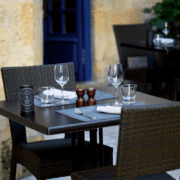
Saint-Émilion train station: direct access to a unique heritage
Imagine stepping off a train and stepping directly into the heart of a historic jewel. The Gare de Saint-Émilion (Saint-Émilion train station) is not just an arrival point: it is the gateway to a unique heritage. Here, every step brings you closer to the rich history and vibrant culture of one of the world’s most famous wine regions.
In this corner, the train station becomes a prelude to an unforgettable experience. It fuses the convenience of modern transport with the timeless charm of a landscape steeped in history and tradition.
Before enjoying a free tour of Saint-Émilion we will guide you through the corridors of time, from the elegant architecture of the “Gare de Saint-Émilion” to the cobbled streets of a village that has captivated hearts and palates alike.
Description of the train station
The Saint-Émilion train station is more than just a transit point, it is a charming introduction to the wonders of the region. For tourism and oenology enthusiasts, this station is the perfect start for a wine tasting in Saint-Émilion or one of the first sights to see in Saint-Émilion.
The station’s architecture combines functionality with a touch of rustic elegance, reflecting the historic character of the area. Its stone structures and wooden beams are complemented by modern facilities, creating a cosy atmosphere that welcomes travellers from the moment they arrive.
In terms of connectivity, it plays a crucial role. It is strategically located, connecting the town to Bordeaux in a timely manner. There are even, although much less frequent, trips connecting this picturesque village with Paris, Perpignan, Carcassonne or Tours. Even Barcelona and San Sebastian (in Spain) have connections.
For travellers, the station offers a variety of services designed to enhance their experience. Detailed tourist information is available to help visitors plan their stay. It includes details on free tours, wine tastings and the main attractions of Saint-Émilion.
Modern facilities ensure a comfortable and efficient stay. Lockers, rest areas and car rental services are included, making it easy for visitors to explore the region at their own pace.
Traveller’s experience: from the station to the city
Travelling to Saint-Émilion from Bordeaux train station is an experience that every lover of culture, history and wine should enjoy.
This journey connects two worlds: the vibrant city of Bordeaux and the quiet charm of one of the pretty villages near Bordeaux. For many, Saint Émilion is worth a visit, not only for its famous wine, but also for its rich history and architectural beauty.
From Saint-Émilion station, visitors can immerse themselves directly into the medieval atmosphere of the village.
On leaving here, you’ll find you’re in a traditional wine-growing landscape, some 3 kilometres from the village’s cobbled streets and stone buildings. For those interested in history and culture, visiting monuments such as the monolithic church or strolling along the ancient town walls provides an in-depth insight into the town’s past.
Transport options from the station include buses, taxis and bicycle rental services. For those interested in a more structured experience, there are several tours departing from the station. These offer guided tours of the vineyards, wine tastings and visits to the main points of interest.
Economic and tourism impact
The Saint-Émilion Train Station has had a significant and positive impact on tourism and the local economy, acting as a catalyst for development and prosperity in this famous wine region. Its presence has not only facilitated the flow of tourists, it has also contributed to increasing the visibility of this place as a top tourist destination.
Since its opening, the resort has greatly improved accessibility to the village, attracting a greater number of visitors, both nationally and internationally. This has led to an increase in demand for accommodation, restaurants, wine tasting and tours, directly benefiting local businesses.
In addition, the influx of tourists has encouraged the creation of new businesses and boosted the area’s economy, diversifying its sources of income beyond wine production.
Testimonials from local entrepreneurs reflect this positive trend. Many winery and vineyard owners have noted an increase in sales and bookings since the resort facilitated access to the region. Tour and activity operators have also reported growth in their business.



